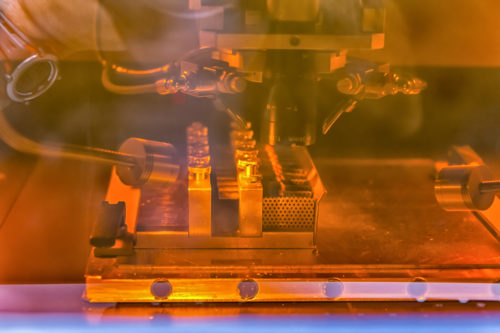
Read on to learn more about the types of spectroscopy and its importance in diverse industries.
Types of Spectroscopy
Spectroscopy is an overarching scientific category; numerous sub-disciplines fall underneath the term. These are mainly categorized based on the type of sample material, wavelength, and the nature of the light interaction. Common spectroscopy types include:
- Fluorescence spectroscopy. A spectrochemical technique, fluorescence spectroscopy examines the fluorescence properties of a sample. The process involves using a beam of light that excites the molecules in the sample that produce light. The light is then directed to a filter and measured for changes in the molecule.
- Raman spectroscopy. This type of spectroscopy analyzes photons’ inelastic scattering. The wavelength of the photon changes after coming into contact with a material. Monochromatic light illuminates the sample, which interacts with the vibrations and causes the energy of the photons to shift up and down. By measuring the energy shifts, spectroscopists get valuable insights into the chemical bonds of the material.
- Infrared (IR) spectroscopy. This form studies the vibrational modes of molecules. This is because photons located in the infrared portion of the electromagnetic spectrum resemble molecular vibrations. Upon measuring the inter-atomic bond vibrations, observers can then determine the types of bonds present in a sample.
- LIBS Laser-Induced Breakdown Spectroscopy.
Spectroscopy Applications and Industries

- Aerospace and space exploration
- Pharmaceutical
- Medical
- Forensics
- Biology
- Geology
- Agriculture
- Food and beverage
- Security (Customs, Defense…)
Spectroscopy can alter a drug’s structure to improve effectiveness, disinfect surgical operating rooms, detect tumors, and analyze blood. This science can also characterize proteins, identify living organisms, study geological samples, purify water, and ensure food quality. It is vital in the aerospace and space exploration fields especially, as mass spectrometers assisted in such groundbreaking applications as putting men in space. Analyzing spectral emission lines of far-off galaxies broadens astronomers’ knowledge of the universe.
Spectroscopy Technology and Trends
Spectroscopy plays a key role in chemical analysis, especially in understanding the chemical composition or structure of compounds. Sectors such as drug manufacturing, food analysis, forensics, and medical diagnosis—with spectroscopy-related technology like MRI machines—rely heavily on spectroscopy to work more efficiently.
Spectroscopy has also benefited the field of physics, as it plays into the concepts of quantum mechanics and electrodynamics, the theory of relativity, and other fundamental hypotheses.
Astronomers depend on spectroscopy to help understand the universe. If ever they make a discovery of life on other planets, spectroscopy will be involved in uncovering that. It is not possible to study other planets in the lab, but using spectroscopy to analyze light from those planets can provide insight into the chemical properties of the matter found there, planet motion, magnetic fields, and more. Equipment for space observation, such as telescopes, utilize spectroscopic technology.
Recent advancements in spectroscopy technology include:
- Detecting and assessing damage in concrete structures with luminescence
- Diagnosing diseases or finding abnormal tissues using MR spectroscopic imaging
- Non-invasive investigation of molecules using vibrational spectroscopy
As the field of spectroscopy advances, optical technology will need to match this pace of progress and technological advancement.
Spectroscopy Instruments, Devices, and Instruments
Numerous devices are applicable for the study of spectroscopy, including spectroscopes, spectrographs, and spectrometers.
What is a spectroscope? This tool utilizes a prism to determine light’s spectral composition. Hand-held spectroscopes allow the passing of light through a slit into the prism, after which an observer can view the light spectrum with the naked eye.
What is a spectrograph? This instrument separates light based on its frequency and records its wavelengths. Spectrographs use a diffraction grating to achieve this. Light will either bounce off or pass through the grating, splitting and bending light into separate rays of different wavelengths and colors.
What is a spectrometer? This device examines the variation of the light bounced off or absorbed by a diffraction grating to measure energy, frequency, wavelength, etc. They are useful for observing spectral range, or the range of the light’s wavelength.
Diffraction Gratings for Spectroscopy
Diffraction gratings are central to spectroscopy. Diffraction gratings help bend light, causing it to split into wavelengths with unique, individual output angles with measurable properties. Users of spectroscopic instruments that utilize diffraction gratings can examine light’s wavelength, strength, and more. These analyses allow scientists and engineers to better understand the characteristics of the material the light interacted with based on how much light passed through and how much the material absorbed.
Diffraction gratings come in a variety of types, such as ruled gratings or holographic gratings, depending on the application. Spectroscopy utilizes diffraction gratings in optical instruments from monochromators and spectrometers to lasers and fiberoptic devices, making them an integral part of the valuable insights that spectroscopy provides in industries like aerospace.
Stock and Custom Diffraction Gratings from OPCO Laboratory, Inc.
At OPCO Laboratory, Inc. we provide design and manufacturing services to produce high-quality, cost-effective optical components like diffraction gratings to clients across industries with minimal lead times. The OPCO team is made up of scientists, technicians, and engineers to reliably handle our clients’ spectrometer design challenges at our ITAR-registered business. For more information about our services ranging from prototyping to production, contact us today or request a quote.
